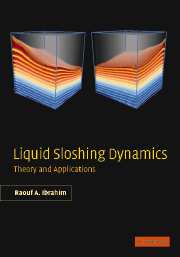Book contents
- Frontmatter
- Contents
- Foreword
- Acknowledgment
- Introduction
- Part I Linear sloshing dynamics
- Part II Nonlinear and parametric sloshing dynamics
- 4 Weakly nonlinear lateral sloshing
- 5 Equivalent mechanical models
- 6 Parametric sloshing: Faraday waves
- 7 Dynamics of liquid sloshing impact
- Part III Sloshing – structure interaction
- Part IV Rotating fluid and low gravity sloshing
- References
- Index
7 - Dynamics of liquid sloshing impact
from Part II - Nonlinear and parametric sloshing dynamics
Published online by Cambridge University Press: 11 August 2009
- Frontmatter
- Contents
- Foreword
- Acknowledgment
- Introduction
- Part I Linear sloshing dynamics
- Part II Nonlinear and parametric sloshing dynamics
- 4 Weakly nonlinear lateral sloshing
- 5 Equivalent mechanical models
- 6 Parametric sloshing: Faraday waves
- 7 Dynamics of liquid sloshing impact
- Part III Sloshing – structure interaction
- Part IV Rotating fluid and low gravity sloshing
- References
- Index
Summary
Introduction
An impulsive acceleration to a liquid can result in impact hydrodynamic pressure of the free surface on the tank walls. It can also occur during maneuvering or docking of spacecraft in an essentially low gravity field. Methods for estimating liquid impact and its hydrodynamic pressure are not well developed and are only identified by experimental studies (Pinson, 1963, Dalzell and Garza, 1964, and Stephens, 1965). It was found that when hydraulic jumps or traveling waves are present, extremely high impact pressures can occur on the tank walls. A hydraulic jump may occur in a liquid container undergoing oscillatory motion if the liquid height is relatively shallow and the excitation frequency is close to the natural frequency of the free surface.
Typical pressure–time history records under sloshing impact condition were reported by Cox, et al. (1980). Feng and Robertson (1971, 1972) studied the liquid propellant dynamics during docking. Rumyantsev (1969a) analyzed the collision of a body containing a viscous liquid with a rigid barrier. Hamlin, et al. (1986) indicated that the hydraulic jump could create localized high impact pressures on the container walls, which has a direct effect on the container dynamics and may result in structural damage. Verhagen and WijnGaarden (1965) reported that close to resonance a hydraulic jump was observed, which travels periodically back and forth between the container walls. This hydraulic jump is a nonlinear phenomenon, analogous to the shock wave appearing in one-dimensional gas flow under similar resonance conditions (Chester, 1964, 1968).
- Type
- Chapter
- Information
- Liquid Sloshing DynamicsTheory and Applications, pp. 405 - 478Publisher: Cambridge University PressPrint publication year: 2005



